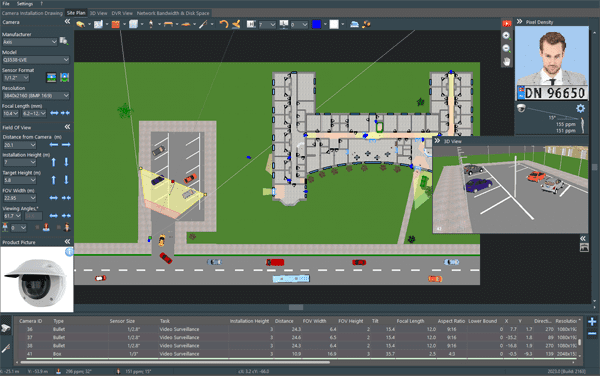When it comes to choosing between Full HD 1080p and 4K resolution, there are several factors to consider. These include the level of detail, cost, bandwidth usage, and specific security requirements. In this article, we will explore the differences between these two resolutions and help you make an informed decision based on your needs and budget.
In the pictures below you can see the difference between pictures from a camera with 4K resolution and FullHD (1080p), when both cameras are placed at the same distance of 11 meters (field of view is 11 meters).
| 1080p Resolution | 4K Resolution |
 |
 |
What resolution is 1080p?
The resolution of 1080p is 1920 x 1080 pixels.
What is 4k resolution in pixels?
The resolution of 4K is 3840 x 2160 pixels.
Content of the article:
Comparing Image Quality: Full HD 1080p vs 4K Cameras
Cost Analysis: 4K Cameras vs Full HD 1080p
Bandwidth Usage of 1080p Cameras and 4K Security Cameras
Specific security requirements for cameras with 1080p and 4K resolution (Video Analytics, Power Supply)
Best 1080p security cameras
Best 4K security cameras
Comparing Image Quality: Full HD 1080p vs 4K Cameras
Difference between 1080p and 4k
The main difference between security cameras with resolutions of 1080p and 4K is the clarity and level of detail in the image.
- 1080p Resolution: 1080p CCTV cameras offer good image resolution, allowing you to see recognizable details in the frame. However, compared to 4K cameras, they do not provide the same level of detailed clarity due to their lower pixel density, especially when zooming in on the footage. 1080p cameras are well-suited for many surveillance purposes. However, if your task involves identification, it is better to consider using 4K cameras or take a more strategic approach to selecting the camera’s installation location using professional video surveillance software. This way, you can choose a suitable location to install a 1080p camera for person identification purposes.
- 4K Resolution: 4K cameras allow you to capture clearer images with more detailed information. They also enable you to zoom in on recorded footage with excellent quality, increasing the chances of identifying objects or individuals. Additionally, the higher pixel density of 4K resolution surveillance cameras, which is four times that of 1080p cameras, allows for more accurate analysis of events.
Below is a screenshot of the video surveillance design software IP Video System Design Tool, which allows you to calculate pixel density and find the optimal camera placement:
Cost Analysis: 4K Cameras vs Full HD 1080p
To conduct a cost analysis comparing the prices of security cameras in 1080p and 4K resolutions, you need to consider several factors:
- Camera Price: The average prices of 1080p security cameras range from $50 to $200. For 4K security cameras, the average prices range from $100 to $500, depending on the brand, features, and additional functionalities.
- Installation Costs: The cost of installation for 4K cameras is generally higher than that of 1080p cameras. This is because 4K cameras need more advanced technology and higher resolution image sensors, which can lead to higher costs for equipment and installation.
- Maintenance Costs: The ongoing maintenance costs for 4K cameras can be lower in the long run. This is because 4K cameras often have better image quality, which can reduce the need for additional cameras in certain situations. Additionally, 4K cameras may require less frequent replacements or upgrades due to their higher resolution and advanced features.
- Storage Costs: The storage costs for 4K cameras are generally higher than the storage costs for 1080p cameras. This is because 4K cameras produce higher resolution video footage, which requires more storage space.
- Long-term Value: Consider the long-term value and benefits of investing in 4K cameras. Evaluate whether the enhanced image quality and finer details provided by 4K resolution justify the higher upfront and maintenance costs.
By comparing these factors, you can determine the cost-effectiveness of 1080p and 4K security cameras based on your specific security requirements and budget constraints.
Bandwidth Usage of 1080p Cameras and 4K Security Cameras
When it comes to bandwidth usage, 1080p security cameras generally require less network resources compared to 4K cameras. This is because 1080p cameras transmit a lower amount of data due to their lower resolution.
On average, a 1080p camera requires a bandwidth of around 2-4 Mbps (megabits per second) for smooth streaming and remote monitoring. This allows for real-time video transmission without significant latency or buffering issues.
In contrast, 4K cameras demand a higher bandwidth due to their larger file sizes and higher resolution. A typical 4K camera may require a bandwidth of around 10-20 Mbps for seamless streaming and remote access.
Therefore, if you have limited network resources or are concerned about bandwidth limitations, opting for 1080p security cameras may be more suitable for remote monitoring. They consume less network bandwidth, allowing for smoother video transmission and reducing the strain on your network infrastructure.
However, it’s important to consider the trade-off between bandwidth usage and the enhanced image quality provided by 4K cameras. If capturing finer details and having superior image clarity are crucial for your surveillance needs, despite the higher bandwidth requirements, then 4K cameras might be the preferred choice.
Ultimately, the decision between 1080p and 4K security cameras should be based on your specific requirements, including available network resources, remote monitoring needs, and the level of image detail desired for effective surveillance.
Here are example screenshots comparing the disk storage for a camera with 1080p and 4K resolution:
You can also estimate bandwidth and storage using JVSG online CCTV storage calculator.
Specific security requirements for cameras with 1080p and 4K resolution
It’s also important to consider video analytics and power supply when choosing between a 4K or 1080p camera.
Video Analytics: If you plan to use advanced video analytics features, such as object detection or facial recognition, with your security cameras, make sure that the camera’s processing power is capable of handling these tasks effectively. Analyzing higher resolution footage requires more computational resources. While 1080p cameras also require processing power for video encoding and analytics, the demands are generally lower compared to 4K cameras. If your surveillance needs include advanced features or analytics that require significant processing capabilities, 4K cameras may be a better solution.
Power Supply: Ensure that the power supply infrastructure can support the power requirements of the cameras, especially for 4K cameras that may consume more power.
Based on anonymized statistics collected by IP Video System Design Tool, a software for designing video surveillance, the following are the most popular security cameras used worldwide in designing video surveillance with 4K and 1080p resolution over the past year:
Best 1080p security cameras:
Best 4K security camera:
In conclusion, choosing between Full HD 1080p and 4K resolution depends on factors such as desired detail level, cost, bandwidth usage, and security requirements.
Full HD 1080p cameras offer decent image quality at a lower cost, while 4K cameras provide better image clarity and finer details.
Consider not only the initial camera prices but also installation, maintenance, and storage costs when comparing costs. Also, take into account the availability of network resources and the trade-off between bandwidth usage and improved image quality.
By carefully evaluating these factors, you can make an informed decision that meets your security needs and budget, ensuring optimal surveillance and peace of mind.
See also:













